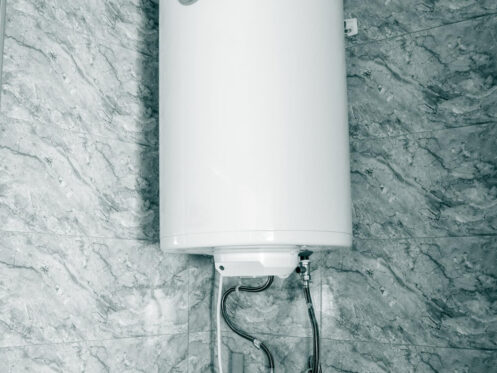When homeowners notice their morning shower isn’t as hot as usual, they often wonder if their water heater is failing.
Most traditional tank water heaters last between 8 to 12 years, while tankless models can provide reliable service for 15 to 20 years. Understanding these timeframes helps families plan for replacements before they’re left without hot water.
Several factors determine whether a water heater reaches its expected lifespan or fails early.
According to the U.S. Department of Energy, water heating accounts for about 18 % of a home’s energy use, making maintenance and efficiency critical for reducing utility costs.
Water quality, usage patterns, and maintenance habits all play crucial roles in how long the unit will function properly. Hard water can cause mineral buildup that shortens lifespan, while regular flushing and inspections can add years to the system.
This guide explores real-world lifespans, common problems that shorten water heater life, and practical maintenance steps that extend performance. It also covers warning signs that indicate replacement time and tips for choosing a durable new unit.
Let’s break down the key points you should consider.
- How long does a water heater last in real homes
- What factors shorten a water heater’s lifespan
- Can regular maintenance extend water heater life?
- When should I replace my water heater instead of repair?
- Choosing the right water heater for lasting performance
Keep reading! Knowing when to repair versus replace a water heater saves both money and frustration.
How long does a water heater last in real homes
Most tank water heaters last 8-12 years while tankless units can reach 15-20 years in actual home conditions. As estimated by the Building Intelligence Center, tank-style water heaters typically last 10–12 years, while tankless models often reach 15–20 years under proper conditions.
Real-world performance often differs from manufacturer estimates due to water quality, usage patterns, and maintenance habits.
The average lifespan of tank and tankless systems
Traditional tank water heaters typically last 8 to 12 years in most homes. These units store hot water continuously, which puts constant stress on the tank and heating elements.
Gas tank water heaters often last slightly longer than electric models. The consistent heating and cooling cycles gradually wear down the tank lining and internal components.
Tankless water heaters perform better with lifespans of 15 to 20 years. They only heat water on demand, reducing wear from constant heating cycles.
| Water Heater Type | Average Lifespan | Key Factors |
| Electric Tank | 8-10 years | Heating element wear |
| Gas Tank | 9-12 years | Burner efficiency |
| Tankless Gas | 15-20 years | On-demand heating |
| Tankless Electric | 15-18 years | Lower maintenance needs |
Premium models with better insulation and corrosion protection may exceed these ranges. Budget units often fall on the shorter end of these estimates.
Why real-world use is different from brochures
Manufacturer estimates assume ideal conditions that rarely exist in real homes. Water quality plays a huge role in how long water heaters actually last.
Hard water contains minerals that build up inside tanks and on heating elements. This buildup forces the system to work harder and reduces efficiency over time.
Heavy usage patterns shorten lifespan significantly. Large families who use lots of hot water stress the system more than small households with light usage.
Poor maintenance habits reduce actual lifespan below manufacturer estimates. Most homeowners skip annual maintenance checks and never flush their tanks.
Installation quality affects longevity too. Improper sizing, poor ventilation, or incorrect electrical connections can cut years off the expected lifespan.
Geographic location matters because of different water conditions and temperature variations. Coastal areas with salty air may see faster corrosion of external components.
Early signs your water heater is nearing the end
Rusty or discolored water from hot taps indicates tank corrosion. This happens when the protective lining inside the tank starts failing.
Strange noises like popping, crackling, or rumbling sounds mean sediment buildup on the bottom. The heating element has to work through mineral deposits to heat water.
Inconsistent water temperature or longer heating times signal failing heating elements. The unit struggles to maintain proper temperatures as components wear out.
Water pooling around the base shows tank leaks. Small leaks often become bigger problems quickly as metal fatigue spreads.
Rising energy bills without increased usage suggest the water heater works harder to produce the same results. Efficiency drops as internal components deteriorate.
Age alone becomes a factor after 8-10 years for tank units. Even well-maintained systems start showing reliability issues as they approach average lifespan limits.
What factors shorten a water heater’s lifespan
Several key factors can cut years off a water heater’s expected life. Hard water, high temperature settings, and installation errors create the most damage over time.
How hard water and sediment cause hidden damage
Hard water contains minerals like calcium and magnesium that build up inside the tank. These minerals form sediment that settles at the bottom of the water heater.
The sediment layer acts like a blanket between the heating element and water. This forces the heater to work harder and use more energy to heat water.
Common signs of sediment damage:
- Popping or rumbling sounds during heating
- Longer time to heat water
- Reduced hot water supply
- Higher energy bills
Over time, sediment hardens into a thick layer. This buildup can cause the tank bottom to overheat and crack.
Hard water also speeds up corrosion inside the tank. The minerals eat away at metal surfaces and protective coatings.
The role of temperature settings in wear and tear
Setting the water heater temperature too high causes faster wear on internal parts. Most units work best at 120 degrees Fahrenheit.
Higher temperatures increase pressure inside the tank. This extra pressure stresses the tank walls and connections.
Temperature-related problems:
- Faster corrosion of metal parts
- Increased sediment buildup
- Higher risk of leaks
- Shortened heating element life
Water heated above 140 degrees can also damage the tank lining. The extreme heat breaks down protective materials faster.
Each 10-degree increase above the recommended setting can reduce lifespan by several years.
Poor installation mistakes that reduce efficiency
Incorrect installation creates problems that last the entire life of the water heater. Many issues start on day one but don’t show up for years.
Common installation errors include:
- Wrong pipe connections
- Missing expansion tanks
- Poor electrical connections
- Inadequate ventilation
- Wrong tank size for the home
Undersized water heaters work constantly to meet demand. This constant operation wears out parts much faster than normal use.
Oversized units cycle on and off too often. This frequent starting and stopping also reduces component life.
Poor electrical connections create heat buildup. This extra heat damages wiring and control systems over time.
Missing or wrong safety devices can allow dangerous pressure levels. High pressure puts stress on all tank components.
Can regular maintenance extend water heater life?
Regular maintenance can add 3-5 years to a water heater’s lifespan through simple tasks like flushing sediment and replacing worn parts. Preventive care also reduces repair costs and helps avoid sudden breakdowns.
Why flushing and inspections improve longevity
Sediment buildup is the top enemy of water heaters. Minerals from hard water settle at the bottom of the tank over time. This creates a barrier between the heating element and water.
The sediment forces the heater to work harder. It also causes hot spots that can crack the tank lining. These problems cut the unit’s life short.
Annual flushing removes this buildup. The process involves draining the tank completely. Then fresh water flushes out the remaining sediment.
Most experts recommend flushing once per year. Homes with very hard water may need it twice yearly. The task takes about 30 minutes and costs nothing if done yourself.
Regular inspections catch small problems early. Check for water leaks around the base. Look for rust spots on the tank exterior. Test the pressure relief valve by lifting its handle briefly.
These simple checks prevent minor issues from becoming major repairs. A small leak can become tank failure if ignored.
The importance of replacing anode rods
Anode rods protect water heater tanks from rust. These metal rods attract corrosive elements in the water. They sacrifice themselves to save the tank walls.
Most anode rods last 3-5 years. They slowly dissolve as they do their job. Once they’re gone, rust attacks the tank directly.
Replacing the anode rod costs $20-50. This small investment can extend tank life by several years. New tanks often come with magnesium rods. Aluminum rods work better in areas with soft water.
Check the anode rod every 2-3 years. Remove it using a socket wrench. If less than half an inch of metal remains, replace it immediately.
Some homeowners never replace anode rods. This mistake often leads to premature tank failure. The replacement cost is tiny compared to buying a new water heater.
How preventive care avoids costly emergencies
Water heater failures often happen at the worst times. Cold mornings or holiday weekends create urgent situations. Emergency repairs cost 2-3 times more than planned maintenance.
Temperature settings affect lifespan significantly. Most units ship set to 140°F. Lowering this to 120°F reduces stress on components. It also prevents mineral buildup and saves energy.
Preventive care includes checking electrical connections. Loose wires create heat and fire risks. Inspect the venting system on gas units. Blocked vents cause dangerous carbon monoxide buildup.
Replace old supply lines before they fail. Rubber hoses last about 5 years. Braided steel lines last much longer. A burst supply line can flood your home.
Regular maintenance costs $100-200 per year. Compare this to $1,200-2,000 for emergency replacement. The math clearly favors prevention over reaction.
Professional inspections every few years catch problems homeowners miss. Technicians spot early signs of tank corrosion and component wear.
When should I replace my water heater instead of repair?
Several factors determine whether replacement makes more sense than repair. Age, repair frequency, and cost comparisons all play key roles in this decision.
Warning signs that repair is no longer cost-effective
Water heaters over 10 years old typically require more frequent repairs. Tank-style units lasting 8 to 12 years show clear signs when replacement becomes necessary.
Age-related indicators:
- Units over 8 years old with multiple recent repairs
- Frequent service calls within a 12-month period
- Original warranty has expired
Physical damage signs:
- Rust or corrosion on the tank exterior
- Water pooling around the base
- Strange noises like popping or rumbling
Temperature problems signal major issues. Water that never gets hot enough or takes too long to heat indicates internal component failure.
Performance decline:
- Inconsistent water temperature
- Reduced hot water capacity
- Longer heating times than normal
How repair costs compare to new system installation
The 50% rule helps homeowners decide. If repair costs exceed 50% of a new unit’s price, replacement makes financial sense.
Typical repair costs:
- Heating element replacement: $200-400
- Thermostat issues: $150-300
- Tank repairs: $300-600
New installation costs:
- Tank water heaters: $1,200-2,500 installed
- Tankless units: $2,500-4,500 installed
Multiple repairs within two years often exceed half the replacement cost. Frequent service calls add labor charges that make replacement more affordable.
Emergency repairs cost more than planned replacements. Weekend or holiday service calls include premium rates.
Why early replacement saves money and energy
Older units consume significantly more energy than new models. Energy efficiency improvements reduce monthly utility bills immediately.
Energy savings benefits:
- New units are 20-30% more efficient
- Lower monthly heating costs
- Reduced environmental impact
Planned replacement prevents water damage. Tank failures can cause thousands in property damage from flooding.
Financial advantages:
- Avoid emergency installation fees
- Take advantage of rebates and tax credits
- Prevent costly water damage repairs
New water heaters come with warranties covering parts and labor. This protection eliminates repair costs for several years.
Modern units feature better insulation and advanced controls. These improvements maintain consistent temperatures while using less energy.
Choosing the right water heater for lasting performance
Smart buyers focus on specific features, professional setup, and warranty protection to maximize their water heater investment. These factors directly impact how long the unit will serve their home.
Features that make a heater last longer
Tank material and coating make the biggest difference in longevity. Glass-lined tanks resist corrosion better than basic steel tanks. Look for units with thick glass linings and additional protective coatings.
Anode rods protect the tank from rust. Aluminum anode rods work well in most areas. Magnesium rods suit homes with soft water. Some premium models include powered anode rods that last much longer.
Insulation thickness affects both efficiency and lifespan. Thicker insulation keeps water hot longer and reduces stress on heating elements. Units with 2-3 inches of foam insulation perform better than basic models.
Temperature and pressure relief valves prevent dangerous pressure buildup. High-quality valves last longer and provide better protection. Check that replacement parts are easy to find.
Digital controls help maintain steady temperatures. This reduces wear on heating elements. Models with diagnostic features can alert homeowners to problems early.
The benefits of professional installation and warranties
Professional installation prevents most early failures. Certified plumbers ensure proper venting, electrical connections, and water line hookups. Poor installation causes 60% of premature water heater problems.
Extended warranties signal manufacturer confidence. Look for units with 6-year or longer tank warranties. Parts and labor coverage adds extra protection. Some manufacturers offer 12-year warranties on premium models.
Proper sizing requires professional calculations. Undersized units work too hard and fail early. Oversized units waste energy and money. Professionals use peak demand calculations to choose the right capacity.
Code compliance protects homeowners and insurance coverage. Licensed installers know local requirements for venting, electrical work, and permits.
Questions to ask before upgrading your unit
What type fits your household needs? Tankless units last 20+ years but cost more upfront. Traditional tanks last 10-15 years with lower initial costs. Consider your hot water usage patterns and budget.
How much space do you have? Tankless units mount on walls and save floor space. Tank units need clearance for maintenance. Measure your installation area before shopping.
What fuel type works best? Natural gas units heat water faster than electric models. Electric units work where gas lines don’t exist. Gas units typically last 8-12 years while electric units last 10-15 years.
What’s your local water quality? Hard water shortens tank life significantly. Homes with hard water benefit from water softeners or tankless units. Ask about special coatings for harsh water conditions.
How important is energy efficiency? ENERGY STAR certified units use 10-15% less energy. Higher efficiency often means better construction quality and longer life.
Conclusion
Water heaters serve homes for many years when properly maintained. Tank water heaters last 8 to 12 years on average. Tankless models can reach 20 years or more.
Several factors affect how long a water heater works:
- Water quality – Hard water reduces lifespan
- Usage patterns – Heavy use shortens life
- Installation quality – Poor setup causes early failure
- Regular maintenance – Proper care extends years of service
Homeowners should watch for warning signs that replacement time approaches. Rust-colored water, lukewarm temperatures, and strange noises indicate problems. Rising energy bills also suggest declining efficiency.
Regular maintenance makes water heaters last longer. Annual inspections catch issues early. Flushing the tank removes sediment buildup. Replacing worn parts prevents bigger problems.
Planning ahead saves money and prevents emergencies. Water heaters over 10 years old need closer attention. Budget for replacement before complete failure occurs.
The type of water heater matters for longevity planning. Tankless units cost more upfront but last nearly twice as long. Traditional tanks cost less but need replacement sooner.
Proper care and timely replacement keep hot water flowing reliably. Understanding these lifespans helps homeowners make smart decisions about their water heating systems.
Contact Splash Plumbing to schedule a professional inspection or plan your next water heater replacement before performance issues arise.












